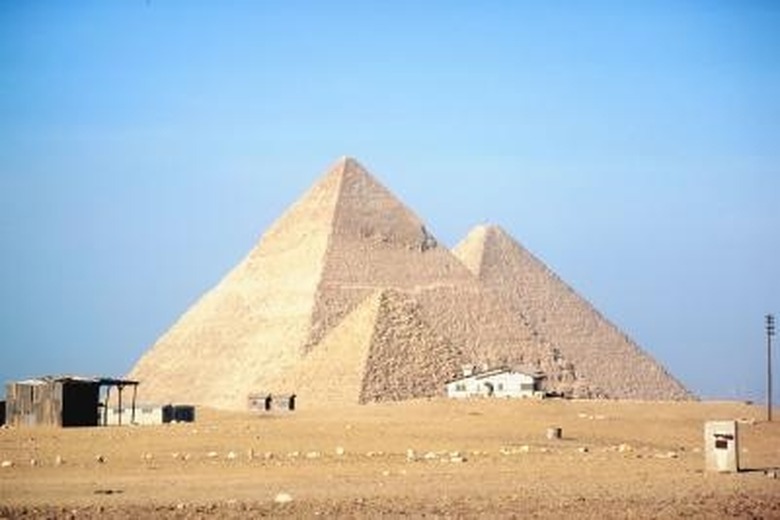How To Calculate The Base Of A Shape
Four types of mathematical solids have bases: cylinders, prisms, cones and pyramids. Cylinders have two circular or elliptical bases, while prisms have two polygonal bases. Cones and pyramids are similar to cylinders and prisms but have only single bases, with sides that slope up to a point. While a base can be any curved or polygonal shape, some shapes are more common than others. Among these are the circle, ellipse, triangle, parallelogram and regular polygon.
Circle
Step 1
Measure from the center of the circle to its edge. This is the length of the radius, "r."
Step 2
Substitute the value of "r" into the equation for the area of a circle: area = πr^2. Note that π is the symbol for pi, which is approximately 3.14.
For example, a circle with a radius of 3 cm would yield an equation like this: area = π3^2.
Step 3
Simply the equation to determine the area of the base.
π3^2 simplifies to 3.14(9), or 28.26. Therefore the area of the circular base is 28.26 cm^2.
Ellipse
Step 1
Measure the vertical distance from the center of the ellipse to the edge. Call this distance "a."
Step 2
Measure the horizontal distance from the center of the ellipse to the edge. Call this distance "b."
Step 3
Substitute these values into the equation for the area of an ellipse: area = πab.
For example, if a = 3 cm and b = 4 cm, the equation would look like this: area = π(3)(4).
Step 4
Simplify the equations to determine the area of the base.
π(3)(4) simplifies to 37.68. Therefore the area of the elliptical base is 37.68 cm^2.
Triangle
Step 1
Measure the height of the triangle from the baseline to the tallest vertex. Call this value "h."
Step 2
Measure the length of the base. Call this value "b."
Step 3
Substitute these values into the equation for the area of a triangle: area = 1/2bh.
For example, if h = 4 cm and b = 3 cm, the equation would look like this: area = 1/2(3)(4).
Step 4
Simplify the equation to determine the area of the base.
1/2(3)(4) simplifies to 6. Therefore the triangular base is 6 cm^2.
Parallelogram
Step 1
Measure the height of the parallelogram. For rectangles and squares, this is the distance of the vertical side. For other parallelograms, it is the distance from the baseline to the shape's highest point. Call this value "h."
Step 2
Measure the length of the base. Call this value "b."
Step 3
Substitute these values into the equation for the area of a parallelogram: area = bh.
For example, if b = 4 cm and h = 3 cm, the equation would look like this: area = (4)(3).
Step 4
Simplify the equation to determine the area of the parallelogram.
(4)(3) simplifies to 12. Therefore the area of the parallelogram base is 12 cm^2.
Regular Polygons
Step 1
Measure the length of one side, then multiply this number by the number of sides. This gives you the perimeter of the shape. Call this value "p."
For example, if one side equals 4.4 cm and the shape is pentagon, which has five sides, p would equal 22 cm.
Step 2
Measure the distance from the center of the shape to the middle of one side. This is called the apothem. Call this value "a."
Step 3
Substitute these values into the equation for a regular polygon: area = 1/2ap.
For example, if a = 3 cm and p = 22 cm, the equation would look like this: area = 1/2(3)(22).
Step 4
Simplify the equation to determine the area of the base.
1/2(3)(22) equals 33. Therefore the pentagonal base equals 33 cm^2.
Cite This Article
MLA
Arnold, Kylene. "How To Calculate The Base Of A Shape" sciencing.com, https://www.sciencing.com/calculate-base-shape-8625802/. 24 April 2017.
APA
Arnold, Kylene. (2017, April 24). How To Calculate The Base Of A Shape. sciencing.com. Retrieved from https://www.sciencing.com/calculate-base-shape-8625802/
Chicago
Arnold, Kylene. How To Calculate The Base Of A Shape last modified March 24, 2022. https://www.sciencing.com/calculate-base-shape-8625802/
